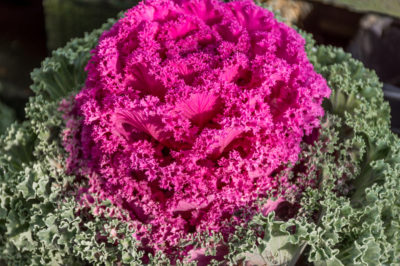Types of Ornamental Kale
Ornamental kale comes in colors that range from white through pink to red and on to purple. The leaves can be plain, ruffled, or frilly and feathery. Some popular varieties include:
- Peacock Kale – frilly and feathery serrated leaves with red or white centers
- Coral Prince – fringed leaves with centers in a range of pinks
- Kamone Coral Queen – fringed leaves with centers that range from coral to purple
- Color Up Kale – plain leaves with magenta or white centers
- Chidori Kale – curly leaves with white or purple centers
Hint
If you’re fascinated by the vibrant colors and intricate patterns of ornamental kale, why not bring them to life on paper? Check out the Cabbage Coloring Pages at ColorConfetti.com and get creative with your crayons and colored pencils. Perfect for kids and adults alike!
Growing Ornamental Kale From Seed
Ornamental kale’s primary purpose is to add interesting texture and dimension to your flowerbeds with an end-of-season burst of color that comes as most flowers are fading. Kale’s colors brighten as temperatures cool, and it can survive to temperatures as low as 5°F (-15°C).
Since ornamental kale is not grown for spring harvests, and since it does not respond well to summer heat, you should wait until temperatures start to cool in late summer or early fall to plant or transplant your ornamental kale plants.
If you want to grow your ornamental kale from seeds, keep in mind that kale seeds require soil temperatures to be between 40°F (4°C) and 70°F (21°C) in order to germinate. In the summer, outdoor soil temperatures could warm well above that. You will need to find a cool place to keep your seeds once you plant them.
Your seeds also require light to germinate, so you should not cover them with soil.
Plant your seeds six to 10 weeks before the first frost date in your area.
Transplanting Ornamental Kale
If you are purchasing ornamental kale to transplant, it will not grow much larger after you move it to your flowerbeds. Even though buying larger plants costs more, you should buy ornamental kale plants that have reached the size you need and that are at or near full color.
Both ornamental and culinary kale prefer full to partial sun with well-drained, sandy or loamy soil. Place the plants so that the lower leaves are even with the surface of the soil after the roots are covered. Ornamental kale also lovely when grown in containers.
Ornamental kales grow to be about 12 inches in diameter and about 15 inches tall. They are smaller plants than culinary kale, so they can be planted closer together.
The colors of the leaves will fully develop when temperatures cool to below 50°F (10°C).
Ornamental Kale Pests
Ornamental kale attracts the same pests as culinary kale – aphids, cutworms, and cabbage moth caterpillars. However, because ornamental kale is planted in late summer or early fall when many food sources are available and the pests already have their favorite munchies picked out, your ornamental kale is less likely to come under serious attack.
Ornamental Kale in the Kitchen
If you really want to eat some of your ornamental kale, you can counteract the extra bitterness of the taste by blanching it:
- Clean your kale leaves.
- Choose a pot large enough to contain enough water to cover your kale.
- Bring the water to a rolling boil.
- Drop the kale leaves in the water.
- Set a timer for 2 to 3 minutes.
- When the timer goes off, use a slotted spoon to transfer the kale leaves to an ice water bath for 2 minutes.
- Discard the water in the pot, refill it, and bring another pot of water to a rolling boil.
- Taste test your kale. If it is still too bitter, blanch it a second time.
The bitter taste may be so strong that you might prefer to sauté your ornamental kale or add it to stir fry, soup, or stew rather than serve it in a salad.
Because ornamental kale leaves are so tough and bitter, it is more often used as a pretty garnish. For example, you could make individual gelatin molds and plate them by unmolding them on top of a decorative leaf of ornamental kale. Do warn people about the not so lovely taste before anyone starts to eat that lovely leaf, though.
